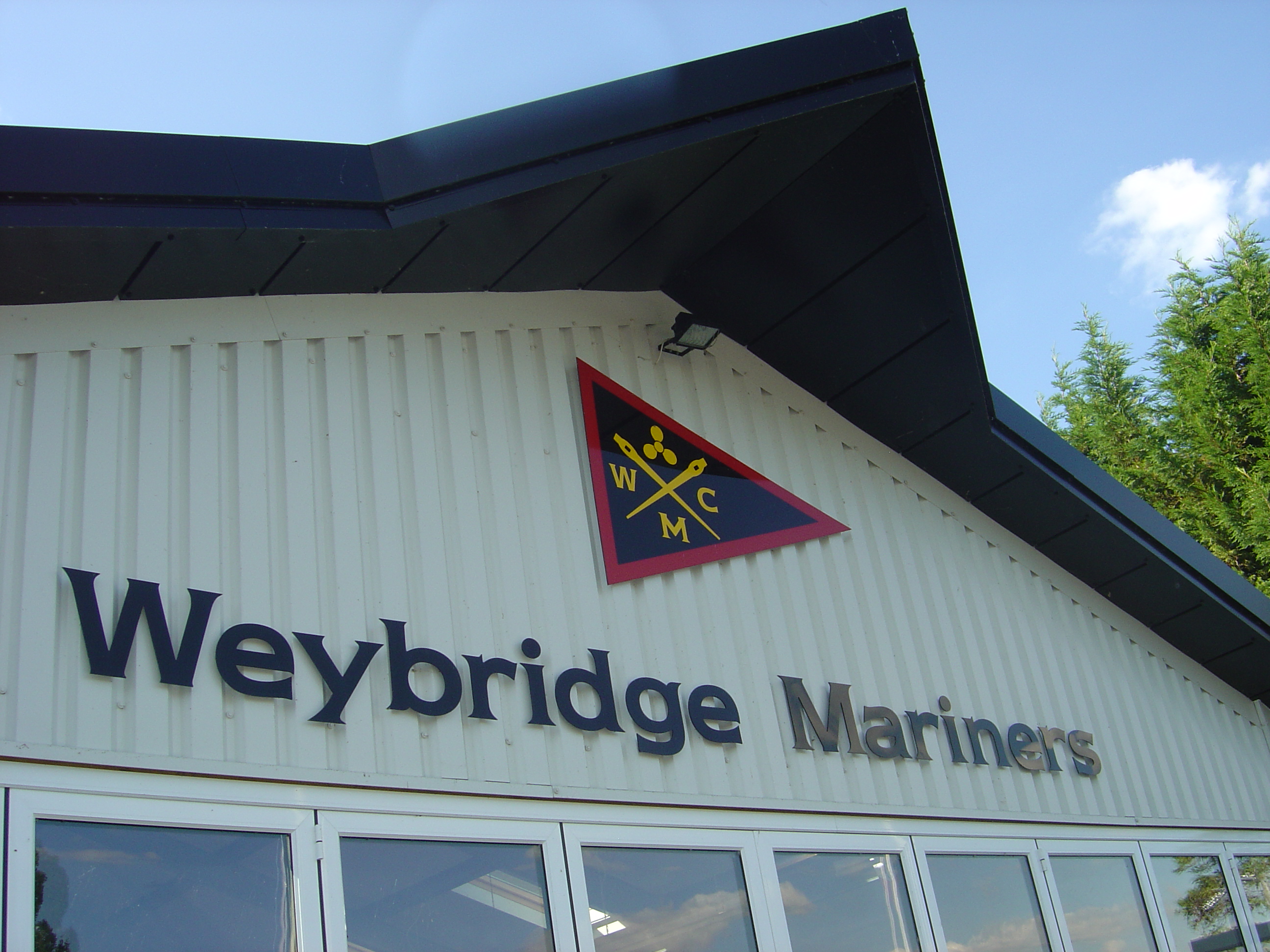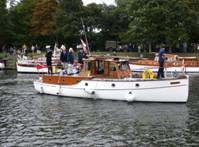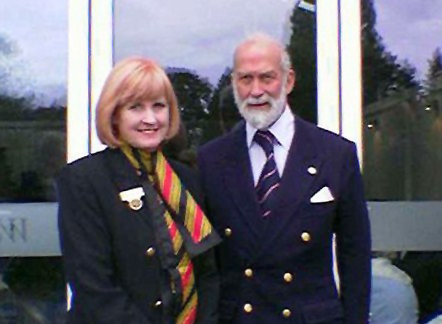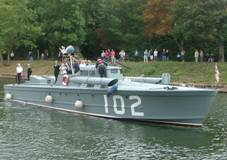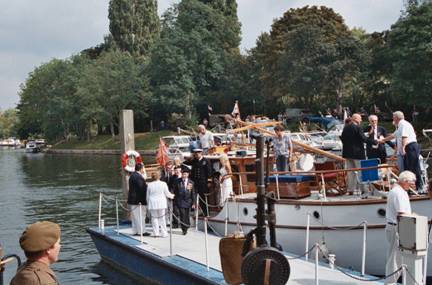Cruise to Paris - August 2002
Articles > Cruise to Paris
I had been encouraged by Ken Brown a fellow single engine Broom 30 owner who had covered over 41,000 miles with his vessel Carlos III. He had shown me many photographs of his boat Carlos III in the Mediterranean ports.
I let Charles Worby our Down River Commodore know that I was keen to go to Paris this year. Although it is possible to do this in a 2 week holiday it does not allow much time to be spent in Paris nor allow for the unexpected or hold ups for weather. The result was that the Down River Cruise was set for the south coast. However, it was decided that it would take in Calais so as to accompany me across the Channel. This was much appreciated.
Thus Su and I set off aboard Alouette at 2pm on the 2nd August 2002 making for Teddington in company with Bill and Angie Jenkins aboard Gwenny and Peter Towerzey and Bob Sumner aboard Summertime. At Teddington we met up with Keith and Pat Davies on Bacara and Charles and Jan Worby on Mustard. There were 2 other WMC vessels at Teddington. These were Del Buoy 2 (Derek Dale, Brian Ridge and Phil Walker) and Paula Joanne (Angie and Brian Bird). Del Buoy 2, Paula Joanne, Bacara and a non WMC boat Sea Lady were initially bound for Thurrock Yacht Club and then Ramsgate. The rest of us were initially bound for Queenboro’ and Ramsgate. Bacara was to meet up with Mustard, Gwenny and Summertime on their return from Calais for their South Coast Cruise.
Sunday we let go at 10.30am for Ramsgate. Sea conditions were perfect and Su was thrilled to be at the wheel taking Alouette round North Foreland. We all arrived at Ramsgate just before 4 pm. Bill Jenkins aboard Gwenny was concerned that he needed additional spare fuel filters. Tom Brown, a friend of ours at Ramsgate who has spent his life on the harbour, having fished for many years with his trawler and still with the Ramsgate lifeboat, did his best to help locate but with no success. I took the opportunity to refuel at the fuelling barge with Tom acting as crew.
Bill and Peter worked on Gwenny’s fuel system during the afternoon. The evening was spent having an Indian meal at a restaurant just down from the Royal Temple Yacht Club where we called in on the way back to our boats. It was an early night as we needed to leave before daybreak Monday morning. The agreed plan was for Alouette to leave half an hour before the others due to her slower speed. Thus, we exited Ramsgate Harbour at 3.30am in the dark. The sea was relatively calm but the large numbers of lights meant we took extra care since Su was unused to identifying buoys by their light characteristics. We advised Dover Coastguard of our TR and ETA for Calais. A little later we spotted the 3 other boats coming up behind us and we crossed the shipping lanes together.
Our entrance to Calais was delayed due to Gwenny again having fuel problems. We watched as Summertime took her alongside hampered by the wake of the high speed ferry which was also making for the Calais harbour entrance Once inside we all locked into the Bassin de l’Ouest. The plan from here was for Gwenny to get her filters sorted and for Su to return to Dover aboard Gwenny.
Thus while Peter and Bill worked on Gwenny, I went up to the CNF office to get my Inland Waterways licence. The office is not manned all the time but fortunately it was open on my arrival. Sylvia, the lady in charge was most helpful. I found that there was another British boat going into the inland Canal system. This was a sailing vessel called Valencia. On my return I made contact since we were to enter the system together in the morning. The skipper and his partner were bound for Lyons. We agreed that he would call the Port Control for both of us in the morning since this is a very busy radio station.
Tuesday morning as instructed by the Port Control , I moved round to the Bassin Carnot with Valencia. Su and the others walked along the Boulevard des Allies to watch our entrance into the Bassin Carnot and then through the Ecluse de la Batellerie where they waved me off.
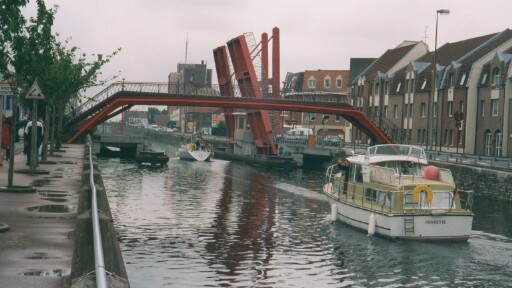
Alouette approaching lifting bridges coming out of Calais
After exiting the lock there are 4 lifting bridges that have to be negotiated. These are operated by a lock-keeper who travels by car from one to the other. Unfortunately we clashed with his lunch-time and thus were considerably delayed on this first part of my journey to Paris .
Later in the afternoon I passed a British vessel coming towards me. It was Trionix with Naomi and David Bradbury returning from an extended continental cruise. This was quite a surprise as Trionix moors some 20 properties down river from us just above Penton Hook lock. Naomi called me up on Channel 6. We exchanged news and I told her that Su and the others were in Calais. Su later tells me that they all subsequently met up in Calais.
The Canal de Calais is notorious for duckweed which clogs up the raw water inlet filter. My water temperature gauge was usually a good indicator of potential problems as the reading would creep up some 10 degrees. Fortunately, on this run I had only one stop to clear the filter.
Travelling alone certainly educates one in boat handling. My initial efforts with the big French locks were totally inept. I was using a long line covering the total depth of rise or fall of the lock. The problem is that when you have a long line you are unable to control the boat irrespective of the fact that you are able to use your engines in the French locks. This meant that I had to use a second short line, which I would try and loop over a suitable bollard. These are positioned at various heights in the lock walls. Once at the bottom of the lock when going down, I would pull the longer line in which would come crashing down either onto the boat or into the water. The solution I found to be to tie a bowline in a short line to make a loop, which could be hung over the bollards as I reached them. This I could hold and with the use of my engine keep the line at 90 degrees for most of the time. Depending on conditions I was able to hold the vessel either direct or taking half a turn round my centre cleat. The worst scenario with this method is that you are unable to get the loop off quickly enough when dropping. On one occasion I was in this position. However, by letting the line go I was able to lift it clear with a boat hook which I had ready for such an emergency.
A second tip I found useful was to use 2 bulbous fenders, one forward and one towards the after end on the side that I was going to come alongside in the lock. These I found not only protected Alouette from the concrete sides which were frequently very dirty and slimy, but also indicated to everyone which side I preferred to use.
Back to the trip – after passing Douai I moved onto Courchelettes where I stopped at the ‘port fluvial’ (I believe this translates as ‘river marina’ but usually seems to be no more than free bankside mooring for pleasure craft). Here I cleared my raw water filter and topped up the engine oil. After lunch aboard I moved off as it was some 2 hours cruising before I would reach the Canal du Nord. I was surprised at how few non-commercial vessels there were. I was often travelling many hours without passing any boats at all.
I reached the Canal du Nord at 5 pm. Most of the locks were now of a guillotine form. After passing through 2 locks I ended the day at 7.30pm moored up behind a single loaded Belgium peniche called Serenad. The skipper was bound for Janville just north of Paris. His knowledge of the route was to prove very useful to me since I found that, although he was slow going into and out of the locks, he was faster than me once he was well away.
Thursday 8th August 2002. Serenad moved into the lock as soon as the lock keeper came on duty. I followed on Alouette. We passed through 3 sets of locks before 8 am. At 8.15am a Princess 41 called Manx Princess passed us coming north. At the next lock I found that although Serenad went through, the lights change and I assume I am not permitted to enter. Thus I lost the peniche. When entering later I queried this with the lock keeper who stated that the lights were not working properly. I suspect the reality is that they are not keen on private motor cruisers. The day passes with more locks and a tunnel. At Peronne I forked left and ended the day at Pont L’ where I tied up behind Serenad which I have finally caught up with again.
Serenad is away first thing in the morning. Again I follow. I am now becoming quite proficient in and out of the locks. Mid-morning I meet my first double width lock at Bellerive. Whilst in the lock we are able to cross the road to a Boulangerie for fresh bagettes. Soon after we go right and then left to reach the junction of the Oise/Aisne. At mid day I tie up alongside Serenad for the lunch break. After lunch we enter lock No 1 de Venette – It is now only 96km to the Seine.
Serenad now speeded up and I found I needed to increase to 2000 rpm to keep up with her. <>However, at last we were seeing some private pleasure craft, mainly Pedros , which seem to be very popular here. Our day finished at Boron lock where again I tied up behind Serenad.
Soon after lunch Serenad turned off for Janville. We exchanged waves and I slowed down for the double peniche called Sanctia Teresia to pass since I understood she was bound for the south of Paris. I followed her into the next lock, which was again a double width lock. I tied up a good distance back since there was plenty of room and we were the only vessels going through. On exiting the peniche came astern moving her after end towards the centre of the lock. Although I knew the skipper was aware that I was behind him I decided to move further back in the lock. I let go of my single midships line. THIS WAS A BIG MISTAKE ! The peniche put full power on and before I knew it I was facing the way I had come in and the peniche was moving out in the opposite direction. Although I had been behind Serenad through many locks the power of these double peniches was something I had not experienced. Fortunately, there was no harm done and I was able to motor round to exit in the right direction. However, I had lost the peniche I was intending to follow knowing that there is a one way system around the islands operating in the Paris area.
Mid afternoon I decided to pull off the main river to tie up in order to better acquaint myself with the route through Paris. It was 2 hours since I saw Serenad part for Janville. I rounded the bend of a turn off where I could see bollards.To my astonishment I spotted Serenad on the left hand side starting to prepare for discharge. I decided to pull alongside to chat again to the skipper. His route through to where he was docked was clearly shorter than my trip up the Seine. I spent sometime with him whilst he went through my route including the changeover to the left side of the river after Suresnes lock. He then told me of the one way system through the islands of Paris. I thanked him and returned to the main river.
I reached Suresnes Lock just after 5 pm Here you call up on Ch22 ‘Ecluse de Suresnes - ici le petit bateau Alouette - Alouette – montant (upstream) en route Paris’ Probably not good French but I found I managed. It took me some time to get through this lock due to commercial traffic coming downstream. I was alone going upstream. Coming out of Suresnes I crossed to the left side. The scenery was such that I felt I had fulfilled my target and made Paris. I passed an old Renault factory, which is now derelict on the Ile Seguin and soon after spotted the Eiffel Tower. As I neared the centre of Paris the light was beginning to go. All around me were fast moving tripper boats with searchlights picking out the tourist attractions. I was having to pay a lot of attention to not be affected by the wakes of these vessels. Since I was unfamiliar with the one way systems I decided to tie up opposite Notre Dame to work out exactly where the Paris Marina was. This was not a good mooring with all the tourist boats passing. I walked along the Quai de la Tournelle and inquired of the skipper of a peniche being used as a houseboat where the marina entrance was located. He told me but suggested that I moor alongside him and enter in the morning. He also told me that the police would move me from where I was moored. Thus I moved up and moored alongside his peniche houseboat called Zohr.
After helping me tie up the Dutch skipper of Zohr invited me to have dinner aboard with his partner, her son and his girlfriend. Thus after cleaning up I took a bottle of red wine across and spent the evening with them. Zohr had been on this mooring for many years along with half a dozen other live aboard vessels. They had had many fights in the past with the council but were now able to moor officially with water and electricity laid on. Since I was very tired, after thanking them, I retired back to Alouette relatively early.
At 8 am on Sunday 11th August I let go from Zohr and moved upstream passing under 2 further bridges before crossing to a pontoon outside of the Paris Arsenal Marina. Here there are instructions to call on VHF or otherwise press the button for the Capitainerie (Harbour Office). I pressed the button and was informed that I would be locked through in 5 – 10 minutes. Once inside I moored up on the right outside the Port Control and walked upstairs to meet the Harbourmaster Bruno. He did not speak English but I managed to explain that my VHF was out and so I could not call earlier. There was no problem and there were plenty of visitor berths. Bruno conveyed that he was an electrician and had a boat himself in the marina. He offered to come down and help me out. I thanked him and said that if I could not sort it I would take him up on his offer.
The charges are 18.86 euros per night. I was allocated berth 119 nicely near the toilets, showers and laundry room. Once tied up on my berth, I was able to find the problem with my electrics. I had a high resistance connection at the splitter diode on the domestic side. This prevented the alternator from being able to charge the domestic battery. Remaking the connection and starting the engine quickly enabled me to get the VHF working again.
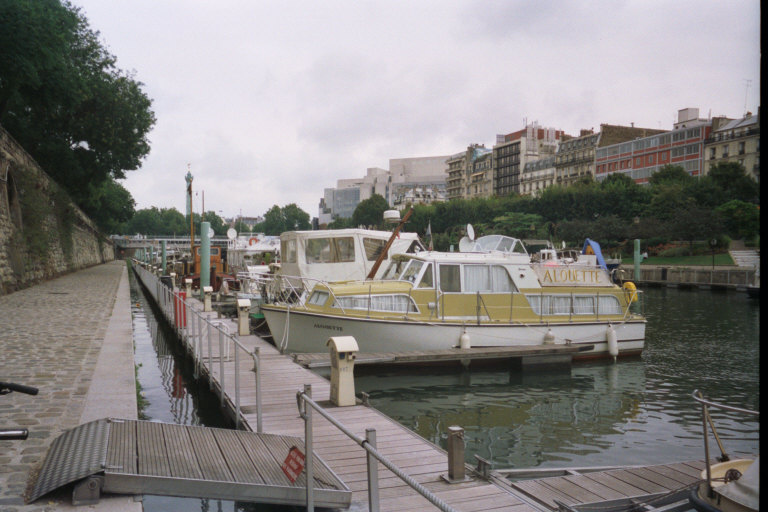
Alouette in the Paris Arsenal Marina
My plan was to stay in Paris until Debs my daughter came out for the return trip. Unfortunately, she was not able to come out until the end of the week. Even then her time was limited and we would have to move off almost immediately.
Thus my time in Paris was spent initially exploring the local area before covering the regular tourist attractions. I found an excellent chandler called Weber Mataux on the Rue de Poitou which sold stainless steel (inox) fittings at prices far below those in England.Notre Dame and the Louvre were within walking distance of the Marina and the Metro stopped over the top of the Marina. There were numerous restaurants in the area.
One day I decided to take Alouette through to far end of the Paris Arsenal marina into the Paris Canal system. Arrangements have to be made via the Port Harbourmaster as the locks will not operate for private vessels without notice. My plan was to cruise the 4.5 km up to the Bassin de la Villette where the Cite des Sciences et de l’Industrie is sited. The trip is along the Canal St Martin which runs through a tunnel under the Boulvards Richard Lenoir and Jules Ferry. I set off just after 8 am so as to avoid the tourist traffic. The passage is monitored on remote TV and entrance to the tunnel is signalled by traffic lights. The tunnel is one way only and runs for about half the distance to the Bassin de la Villette. Although Alouette has a searchlight I found this was not necessary as the tunnel is lit by natural light, which comes through the roof via special openings at intervals. At the end of the tunnel a message in English welcomes you to the Canals of Paris.
Exiting the tunnel you come to a series of double locks i.e. out of one into another. As I entered the first lock and tied up I heard a voice behind me call out in English ‘Alouette would you mind if we took the alongside mooring. It was an English narrowboat called Falcon owned by a vicar from Wigan and his wife. I had not been aware that anyone else was in the tunnel when I came through. They too were in that situation but in their case they saw my stern light and thought someone was coming towards them. Thus two unlikely companions Falcon and Alouette (Skylark) locked through the series of 4 double locks tied together. These double locks raise you 28m which is reported to be more than the rise from the sea via the Seine.
Coming out of the last lock you progress through the Bassin de la Villette and pass under a nineteenth century lifting bridge operated by a light beam. Falcon left me after this to go on to the next canal. I stopped at Port Villette to visit the City of Science exhibition. This is well worth a visit although not all the interactive exhibits include English.
My return journey at the end of the day had me held up a couple of times for the ‘vedettes’ but no problems. Vendettes are the canal tourist boats used on the Paris canal waterways.
The next day Thursday 15th August my daughter Debs flew into Charles de Gaulle airport. I made the trip out to meet her via Metro, train and connecting bus. We returned to the marina and after some shopping she was keen for us to get away. My intention was to refuel at the Touring Club de France just before the Pont des Invalides going downriver. However, I was informed at the Harbour Office that this facility is no longer available. We paid our dues and exited the marina just after lunch.
The trip down the Seine was fabulous. We passed under the many famous bridges which is akin to going through the centre of London with all her picturesque bridges. This is more enjoyable for me than coming up the Seine when I was alone and needed to be keeping a good lookout.
The next re-fuelling possibility is at the junction of the Oise. This time as we passed down the Seine I stopped off to take a picture of Alouette with the Eiffel Tower in the background.
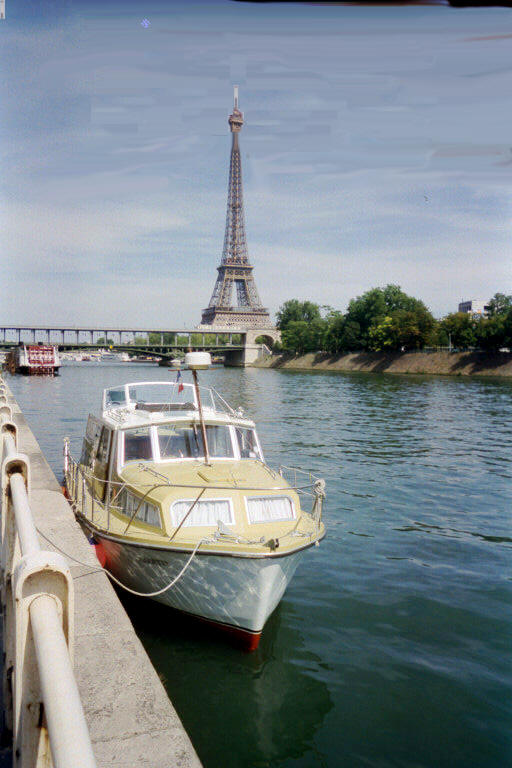
By 4 pm we had cleared Suresnes. We continued down and eventually stopped just upriver of the Chatou, tying up on trees.
Our trip down the Oise was most pleasant and Debs was pleased to be able to sit topside with me taking the sun. We continued until after lunch tying up at Ville de l’Ile Adam. This is a very pretty village with 48 hours Port de Plaisance moorings. After a shopping trip we decided to move off as it was a little early to end the day. Although we had a couple of stops midstream to clear the water filter we were able to get a further 20 miles before tying up again.
Another early start on Saturday. I was again beginning to get concerned about fuel. I was down to 7 gallons in the tank. I put in a further 10 gallons from my reserve cans. I now had only 5 gallons reserve left. Mid-morning we passed an English cruiser called Sapphire coming south and just after lunch we were overtaken by 2 French cruisers Oliver and Elysium which I remembered being in the Paris Arsenal Marina. A little later we caught them up at the lock, which also had a peniche going through. Coming out of the lock one of the cruisers pulled over alongside a fuel barge called St Martin. We pulled up and followed the second cruiser onto the barge. It was then that I noticed that the skipper of Oliver was the Port Captain Bruno from the Paris Arsenal. He and his wife were on a long weekend boating holiday. Having re-fuelled I was happy that we could make it back OK. We said good-bye to Bruno and his wife and continued north.
At 2 pm we turned off onto the Aisne. Two locks later we reached the Ecluse de Bellerive. Two peniches exited but the lock-keeper signalled for us to use the second smaller lock. Our progress continued with us making about 5 knots at 1600 rpm. Our next problem occurred at Noyan Lock No.18. It appeared that a peniche that had entered ahead of us was taken to the top and then brought down again. It took two goes for this vessel to clear the lock after which we entered. After this we motored on to the next lock where we had to stop as the keeper had gone off duty. Debs prepared our meal and we opened another bottle of wine.
Sunday morning was a later start due to the lock-keeper coming on duty an hour later than weekdays. More locks, a tunnel and more locks before we reached the Canal du Nord. The return journey through the Canal du Nord locks I found much easier than when I came south. However, the weather was changing and we were getting some light rain. We reached the entrance to the long tunnel just after 6 pm and tied up behind a peniche. The weather deteriorated further and we were subjected to a severe thunderstorm, which lasted for most of the night.
The next morning I was awoken by the peniche ahead of us moving into the tunnel. I quickly donned some clothes, let go and followed the peniche into the tunnel. There were then more locks before we turned offat 10.45 am onto the Haute Deule sign-posted for Dunkerque. Debs was now looking forward to the Channel crossing. She had previous sea experience in the Mediterranean aboard the safety boat used for the international power-boat racing scene. This canal and river stuff was too tame for her – she had done it all before!
Just before lunch we were joined by a French motor cruiser and 2 Danish vessels. We were with them through 2 locks when we followed the French cruiser turning off at Courcelles. The village was some way from the moorings but the French skipper offered me use of his bicycle to go up to a local supermarket to get more provisions. On my return I was helped to unload by the bicycle owner who recommended that we next stop over at Arques. We said “bon jour” and got on our way mid afternoon.
It was 6.45 pm when we turned into the Bouvry Canal. It was very weedy and we soon came to a low bridge, which prevented further progress. Debs was not keen on mooring here so we turned round to go back. A Mercedes car drew up on the bank and the driver called across. Yes we should moor here – he owned one of the waterside properties and his neighbours spoke excellent English. We turned around and went back to tie up on what Debs thought were private moorings. Our lines were taken by the English speaking couple. They were taking their dog for a walk and owned a very nice property called ‘The Moorings’ next door to where we were tied up.We invited them to have a drink with us on their return. Meantime, Debs prepared our evening meal which we finished before the couple returned with their dog. It transpired that they were Anglophiles and had spent some time in England and more in Wales, which they knew well. Since I was at college in Colwyn Bay I knew many of the areas with which they were familiar. Soon after they left the weather, that we thought we had left behind, caught up with us. We had thunder and lightning again for much of the night.
Tuesday morning we moved off and back to the Canal d’Aire. We continued up to Aire sur Lys where we turned onto the Canal de Neuffosse. On this stretch we decided to pull off for lunch at the Arques marina. The weather was miserable but we were made very welcome. Pierre and his wife suggested spare ribs for lunch. Debs declined settling for ham egg and chips but I accepted. The spare ribs were excellent and we ordered a second bottle of wine. I asked to see the visitors’ book so that I could write something suitable. I found, looking through, that the Weybridge Mariners had been here some 10 years earlier. The rain had stopped when we left and we journeyed on to Holque Watten for our overnight stop. Here we moored up behind a British motor cruiser from Ramsgate. Debs now wanted to do the town. We had a beer in every pub – she seemed more sober than I was which I put down to her having had less wine at lunchtime.
Thus it was just before 11 am that we were able to leave the basin and move through the Bassin Carnot. We tied up again in sight of the exit lock and were told on the VHF to follow the coaster Hoo Swan that would be going out ahead of us. It was just before midday when we got out having to keep well over to port as a large passenger ferry entered. I passed my TR to Dover Coastguard. The channel crossing that Debs had been looking forward to was not quite what she expected. Although the sea conditions were slight with good visibility, as we left the harbour she went down below and I didn’t see her until we were inside Ramsgate Harbour. I afterwards found out that she had called her mum (Su) and said she couldn’t face any more.
I called my sister from Ramsgate Harbour but found that she and her husband were away in France on holiday. Debs’ cousin said that she could stay over and that he would take her to the station in the morning. I got a lift to my friend Tom’s. Tom said he and his cousin Collis would like to do the next leg of my run up to Queenboro' in the morning. This was welcomed. Tom then ran me down to see more friends (George and Val Curtis) down at Pegwell Bay where I stayed over.
Friday morning George took me back to Ramsgate harbour where I was joined by Tom and Collis. Tom and Collis both know the waters off Ramsgate very well – Tom particularly from his trawling days. We moved out of the harbour at 7 am and I called Thames Coastguard with my TR. The forecast for Thames was variable to NW 3 with moderate visibility. It was a very pleasant trip and we arrived at Queenboro’ just before 1 pm. I passed my arrival to Thames Coastguard for relaying to Dover Coastguard. I then dropped off Tom and Collis to be picked up by Toms wife and moved out to the concrete lighter to wait for the morning tide.
Alone again, my last day started at 7.30 am when I moved off from the lighter. Sea conditions were slight although visibility was reduced first thing. There were plenty of other small boats on this run and they seemed to be constantly passing me. I made very good progress through London and arrived at Teddington at 4.45 pm. and was home by 9.20 pm. It had been a fantastic experience and I learnt a lot about handling a boat on the continental waterways.
My total trip from home to Paris including local miles on the Paris canals came to 825 miles. Each direction covered 53 locks including the local ones in Paris and the Thames. Now the bad news - I had used 105 gallons of diesel and almost 2 pints of oil. I wonder if Alouette could be rigged with a sail?
Chris Knight
